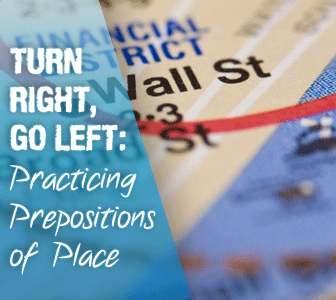
Prepositions of place is one of those topics that can really open up a new world to learners.
It is also a topic with lots of details and possibilities for practice and implementation. Below are some strategies for practicing prepositions of place focusing on location.

How to Practice Prepositions of Place
-
1
Use Maps
To introduce uses for prepositions of place, it is essential to show students the many functions it has in their daily lives. One way to do that is to present students with an overview of a map of their city or town. You can introduce compass directions, prepositions for giving directions as well as prepositions of place and movement. Maps are practical resource to first discuss locations, distances and placements. Then later students can put maps into action. Another topic that can arise out of using maps is landmarks. Students generally know the landmarks of their city, and it can be great fun to utilize those landmarks for direction-giving activities. There are so many possibilities with maps. You can give students the map of one neighborhood and have them practice going to and from one of the popular landmarks. You can have them fill in maps with local landmarks, street names, and popular places like hotels, grocery stores, libraries, etc. Once they have the maps filled in, they can then begin asking for and giving directions. This is a terrific review of all the terminology for prepositions of place and movement! Here is a list that you could include for students to reference:
Movement Place Go straight/move forward On the corner Turn right or left at the light/stop sign/train tracks On the highway Across from Exit to the left Next to Go through the light Behind/in front of -
2
Create an Obstacle Course
If you have a fairly spacious classroom and you take care to make sure this activity stays safe, then by all means go ahead and create an obstacle course. First pinpoint a point A and a point B. Point A is where students will begin and point B is where students want to end. Take a few chairs and spread them out so the path from point A to B is obstructed. Then put a blindfold on one student, who will be turned around a few times. Have another student direct the first student from point A to point B through the obstacle course. You can vary the obstacle course for each different student or you can make it a team event. This is an enjoyable activity that is safe provided students take their time and listen to the directions. It is also a worthwhile activity to debrief afterwards to discuss the importance of understanding directions, navigating difficulties, and asking the right questions.
-
3
Directions from Memory
Close your eyes and think about the route that you follow to get from your home to your office. Could you tell someone every step of that drive or walk? This activity is a lot of fun simply because giving directions purely by memory really isn’t that easy. One way to make it even more engaging is if students who live close to each other can work together to try to get every step in movement absolutely correct. You could also have the students try to trip each other up, or find the gaps in the directions. Another variation on this one could be, for example, from the classroom to the bathroom or from the parking lot to the classroom. You can dream up many ways to have students give directions from memory. An extension of this could be an assignment to draw a map along with the written directions from school to home or home to work.
-
4
GPS and Google Maps
In this technological world, perhaps many of your students are using a GPS system to get around (and to get lost). If they are not familiar with a GPS and you have access to one on your phone or otherwise, introducing the device to students could be very enlightening. Take out the city maps you provided them with earlier and punch in an address close to the classroom. Have students follow where the GPS tells them to go on their map to find out if it is accurate. You could come up with several ways to provide the class with examples, and have students experiment with the GPS.
You could also introduce Google Maps or Map Quest. This is a handy resource that students could use in their daily lives. It also gives them the capability to look at a map while simultaneously getting written directions. You can do activities with your local city or have some fun choosing famous landmarks throughout the world and locating them on a map. You can also introduce them to the other features of the maps (like search nearby or street view) and open up a whole new world to them. The possibilities with these technological tools are endless, and they could generate entertaining and informative ways for students to explore their area and the world around them!
When it comes to getting around and functioning out in the world with limited language, giving and following directions can be a key piece for students to gain some independence and confidence.
Take these ideas and make them as hands-on and relevant as you can for students immediate circumstances, and they’ll navigate themselves right into self-reliance.
P.S. If you enjoyed this article, please help spread it by clicking one of those sharing buttons below. And if you are interested in more, you should follow our Facebook page where we share more about creative, non-boring ways to teach English.







